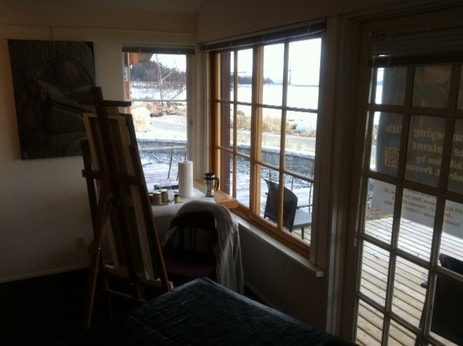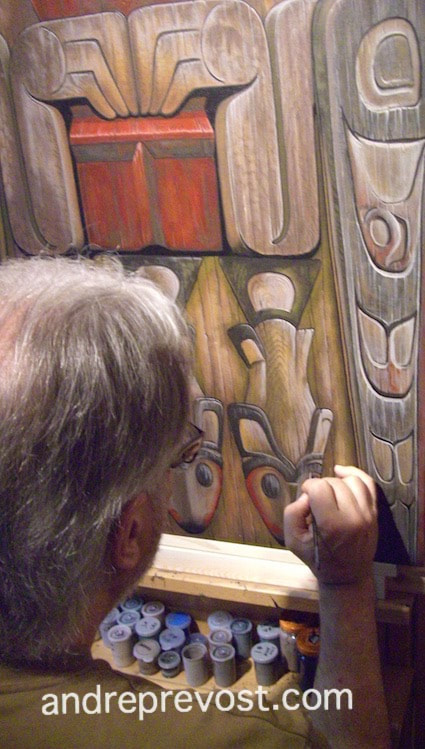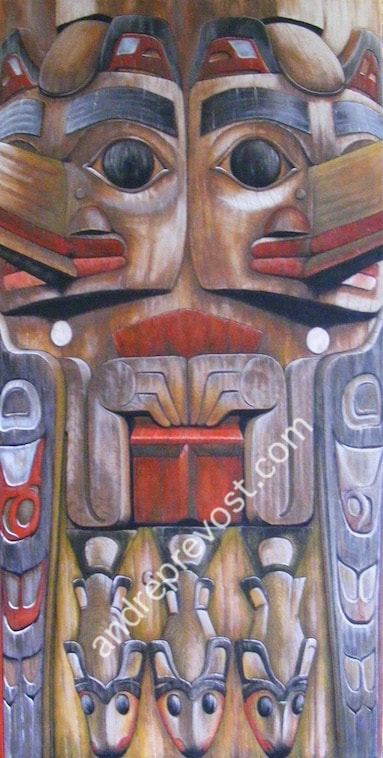0 Comments
Some of the comments from the opening;
“I just want to touch the wood.” “You can also smell the cedar” “Amazing” “They are so real” “I just had to get close to see all the layers and detail” “Is that a photograph?” “Those are painted on canvas, right?” “I love how the totems are so accessible, so close up” “How to you do that!” And then an assortment of explanations about the totems. A number of people completely understood my fit (and approach) with the totems as a non-Aboriginal. I will be working on a new piece in the space during the show hours starting Saturday, January 31st. It would add another level to the exhibition, and it gives me a comfortable way of being there and not make people uncomfortable and easier for them to strike up a conversation as they come and see what I'm doing. The first solo exhibition is here! I start loading the paintings into my van in an hour and then the set up begins at 9:30am. I'll be posting pics.
With the last painting completed for the first solo exhibition that opens in 6 days, yes 6 days, I now begin the process of adding the hanging wire to the series and wrap them for transport.
It has been a wonderful time, a stressful time, and a time of self-evaluation. Completing this last painting has a strong sense of accomplishment, but I am very aware of the fact that I have another solo exhibit 1 week after the first one closes. So my sense of accomplishment is brief as it is overtaken by a tension of being ready for the second show. So I need to tackle a few more paintings during the first showing, and begin design options for an icon commission in Winnipeg. Not having access to any grant funding, I've had to claw my way to these showings through any available credit that I had. It has been a daily stress. With the first exhibit almost here. I now just need to get through to the end of February and hope that there are a few sales. My art isn't solely about sales, but it helps keep a roof over may family's head and allows me to continue painting. As an artist, I am a very private person in general. In my iconography, there have only been a few occasions where I publicly spoke on a particular work. So with this first solo showing, I nervously approach the opening. I've received wonderful comments about the series and specific paintings, and best wishes for a successful show. A successful show would help financially, but the artist in me (as any artist - visual or performance) hopes that the 'reviews' are good as it would affirm my transition in the pursuit of my art. I believe in my own success with the totem series, but can't assume that it will be shared by anyone who comes to see it. The pragmatist in me always insists on being ready for all possibilities. But having said that, am I ready for success? I need to prepare myself to be in front of my art in a public setting, and speak about my transition and the driving force behind my journey with the totems as a non-Aboriginal person. That will be a key point of inquiry at the reception or when meeting a viewer at any point during the exhibition. I know how that connection and interest in totems/carvings (and the vibration of the wood they are carved into) has been part of my life. But it is another thing to try and put it in words 'outside of myself', in a coherent manner. I'm not skilled in 'artsy' speak. It has been the pattern of my life. I had a 25+ years career in theatre production offices even though my initial goal was to design. I have 35+ years in Iconography even though I am not from the Byzantine Rite and not from a Slavic background. I taught art & drama at the high school level for 5 years even though I did not have a teaching degree. I am now deeply set in my totem paintings as a non-Aboriginal. So I guess it comes as no surprise to anyone that knows me. But through all my endeavours, I have approached each in the same way; giving it my best and with sincerity. It was a bit of wisdom that one of the greatest mentors of my life, Gordan Adaskin, imparted to me during my studies at the Banff School of Fine Arts. "When a door presents itself to you, open it. Enter. Even if it is a unexpected direction. Give it your best. If you succeed, rejoice. If you don't, you will know that you gave it your best and you tried. You will have learned something about yourself and you won't have the life long regret or doubt of 'What if I had tried it and not turned it down?'." It has been the main drive of my life since. It has been a life of many changes and directions. And yes, even though it wasn't a conventional job with a nice pension plan at the end of it, it has seen me through all these years. What will be my legacy? It won't be mine to know. A legacy is a daunting thing to assess and it is in continual evolution. For the longest time, I thought it was my production work in the opera world. But when that ended, I thought it was my icons. And now with my transition into my painting? And what impact did I have on any of my students while teaching! The endless questions and pondering of an artistic mind.
My son recently recommended that I keep a journal about my transition in my painting, especially with the totems. I guess it always comes down to time and the real fact that, during a major transition, you are too preoccupied with the stresses and challenges on hand. When leaping into a new direction, there is no way to know what is around the corner on any given day. Adjusting and coping day to day makes it somewhat difficult to take a step back to take an overview of the progression (or regression) to date. I suppose it wouldn't hurt to just jot down notes each day and not worry about making sense of it all (the big bigger) until later. But it hasn't been my pattern to journal my art activity through the years, especially during the 35 years in iconography. In my iconography, aside from my simply monogram and year the icon was written on the back of an icon, the nature of the work generally requires a certain level of anonymity. There is the catch-22 where on one hand, you need to promote yourself in order to become known and get more commissions, but then, with sacred works, the icons themselves have nothing to do with the iconographer when venerated or contemplated. On a few occasions, I was even challenged that I put my monogram on the back of each panel. For some church commissions, when the back of the icons needed to have the same wood finish as the iconostasis it is set within (the frame or screen in front of the sanctuary in the Byzantine Rite), the monogram can't be included. But if you play the anonymity too well, you find yourself still virtually unknown after building a significant body of work. Also in iconography, the artist can't see himself/herself as a typical creative artist, but bound to creating within a tradition which has very distinct guidelines and restrictions. So, in transitioning back into my original painting from years ago, the ingrained iconographic work ethic is hard to set aside and open up again to the possibilities of creative options. Faced with that blank white canvas, where do you begin? The acrylic medium was a given, but what do I start with? The first step was to return to a painting I had started back in 2010, of a young seal peering through an ice hole. When I had reached the half way point on it, the realities of unemployment in Winnipeg were such that I had to take drastic action and look for work elsewhere. (It was an incredibly difficult time for my son and I. He, as a young man now, had decided that he wanted to stay in Winnipeg, and would rent a place with his buddies. So the whirlwind of finding a job led to Vancouver and the most complicated move of my life. The painting was packed along with the studio and off I went; heart-broken to leave my son behind. In 2011, my son joined me on the west coast.) Once finally getting to complete the seal painting 'Welcome World' in 2013, I was back to that blank white canvas! Always interesting how powerful a blank canvas is. It was important to think through where I came from and what direction would make sense for me. Precision and detail had been so ingrained from my iconography. From that tradition, what do I use as a jumping off point! I have never considered myself a landscape artist, nor saw myself as having that particular skill. But then, artists are their own worse critics. With some pointers on multimedia techniques from an artist friend, I decided to try my hand in doing a 24'x24' multimedia piece. Using 4 selected images of ancient icon faces and transferring them to the canvas, I then incorporated them together with painted overlay and details, and using some 22K gold to create a sense of the natural wood decomposition through age. That is where the totems came into play. The idea of aging wood images of the icons in the context of tradition and symbolism was seen as being similar to those of the older totems. That was the bridge I was looking for, and it felt like it was the logical and best route for me to go. It reconnected me to my lifelong love and interest in First Nations art, especially of the west coast. I was also very aware that I myself wasn't Aboriginal and in no way did I want to be seen as doing work in the same way and within the tradition of the many great Aboriginals artists. The distinction of my recent series of totem studies in acrylic is that I am not carving but using my paintbrush and finger tips. Not being from an Aboriginal heritage and culture, I do have the knowledge or 'right' to create a narrative for a totem pole. But the wonderful totems of the west coast are enduring masterpieces for everyone to experience. One of the most cherished times for me is when I have to opportunity to stand by a totem and set my hand on it; feeling its energy. I've always described it as a vibration from the wood and the spirit of the carver(s) etched into it. This too is similar to my experience with icons. For different reasons, they too have a vibration to them because of the prototype portrayed but also from the iconographer who wrote the image. Both are created out of tradition. Both are are created on nature. Both are created through patience, skill, great effort, and in the end, the prime importance is the totem or icon, and less so about the artist. And so I began to scan through my collection of totem pictures that I had taken through the years, through the lens of potential paintings. I had no definite idea yet as to the technique I would use etc. I returned to the Museum of Anthropology at UBC to refresh my connection to them and sit within their presence. I decided to begin with an image of two sections from a totem in the indoor MOA collection. The original totem had been cut into sections in order to transport them and save them as part of the collection. I had determined that, not having a set plan as to how to execute the painting, that I needed to just let the image and painting guide me. It needed to be such for all the paintings as I was in a completely new path of discovery: both 'self' and technique. When I look back to the first few paintings, I am amazed on how quickly they developed towards the style that I am currently doing. The second painting left me needing to move in a different direction. But I had begun discovering my new technique of using my fingers and exploring the 'undertones' and textures of natural wood. My techniques changed greatly with the pair of Grizzly totems, which came next. Even within that pair, you see a distinct change between the first and second. It may be that people see a commonality within all my work, but I am always surprised with where each painting went, and the discoveries each presented. Again, it comes down to my original directive to trust that each image would guide the way. So each painting has a different composition, different colour choices, and overall different treatment. After all, each totem is so distinct within itself. I see each painting as a facet, like that within the beauty of a cut gemstone. My paintings are not landscapes depicting full totems, but focusing on each totems, wonderful in themselves, and featuring the beauty and strength of particular sections within the confines of the canvas size(s). In the process, I try to document as much information as I can for each totem so that I can notate their origins when displaying/showing the paintings. But being true to my sincerity in my love of the totems, I in no way, claim to neither be an expert nor approach the series from an anthropological point of view. I am not just trying to record the totems. Photographs are a better tool for that kind of documentation and recording. I approach the totems in deep respect and allow myself to respond to them at that basic level. Not as an academic. I want to attempt putting on canvas what I experience and share what moves me. I don't necessarily look at images through the initial scan of 'paintings' but I will often go through an image file again an again, and pick those that speak to me the loudest; either composition, the play of light, the patinas of aging woods, the striking beauty of the design, the narrative behind the pole and within each of its sections, etc. And yes, at this stage of my development, the series may be criticized by some as being work which is very structured and doesn't have the bold freedom of contemporary works. But given my background, and the subject matter, my goal is to catch the essence of each totem, its nobility and enduring beauty. So this is my Journey With The Totems. I am open to where it will lead. The work will evolve as it goes, and like you, I have no idea where that will lead. That is part of the unknowns of discovery. For now, I am content with the style which I have developed along the way. The series is unique. And I relish in looking at the works so far and yes, there are the anxieties of the unknowns and financial stresses along with the hard work, but I enjoy the wonder of 'How did I do that?!' Discovering that I didn't know was in me. And I have two solo exhibitions coming up already! Exciting and nervous times. |
Archives
November 2020
|















 RSS Feed
RSS Feed